#vintage computer festival east xii
Explore tagged Tumblr posts
Video
youtube
I’m in the foreground for the duration of Ian’s CRT repair workshop at VCF East XII
5 notes
·
View notes
Photo
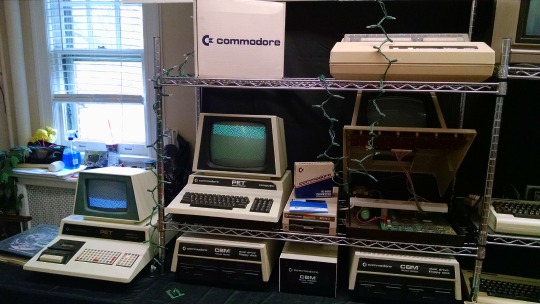
Hey, that’s from the Commodore mega-exhibit from Vintage Computer Festival East XII in 2017. Want to see the source code that makes it tick?
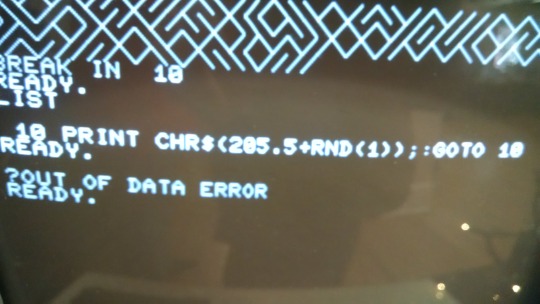
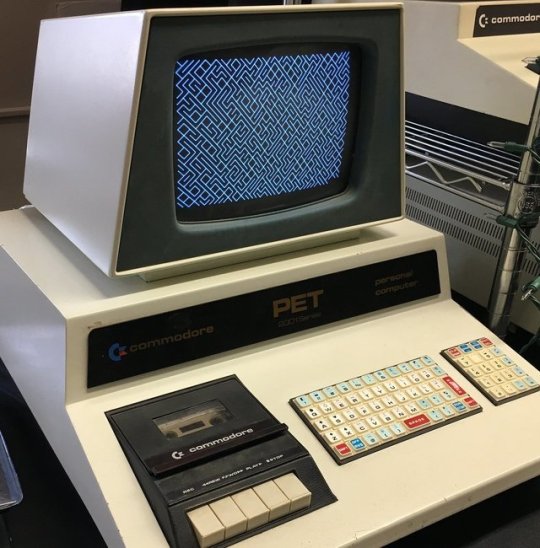
The 10PRINT program running on a Commodore PET, posted by Trammel Hudson, @qrs. 10 PRINT CHR$(205.5+RND(1));:GOTO 10
648 notes
·
View notes
Photo


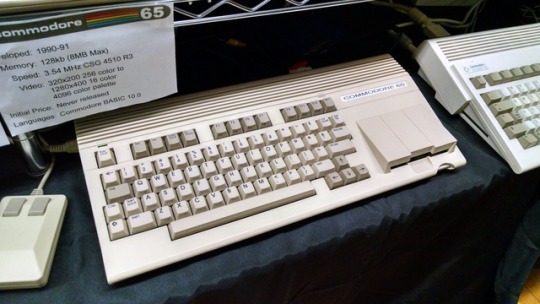
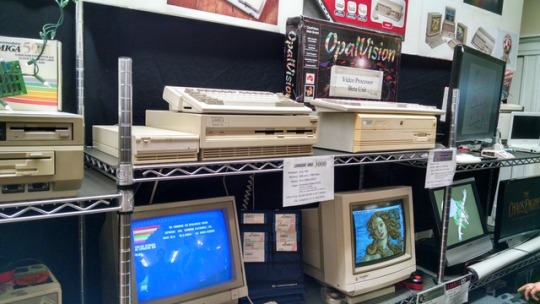
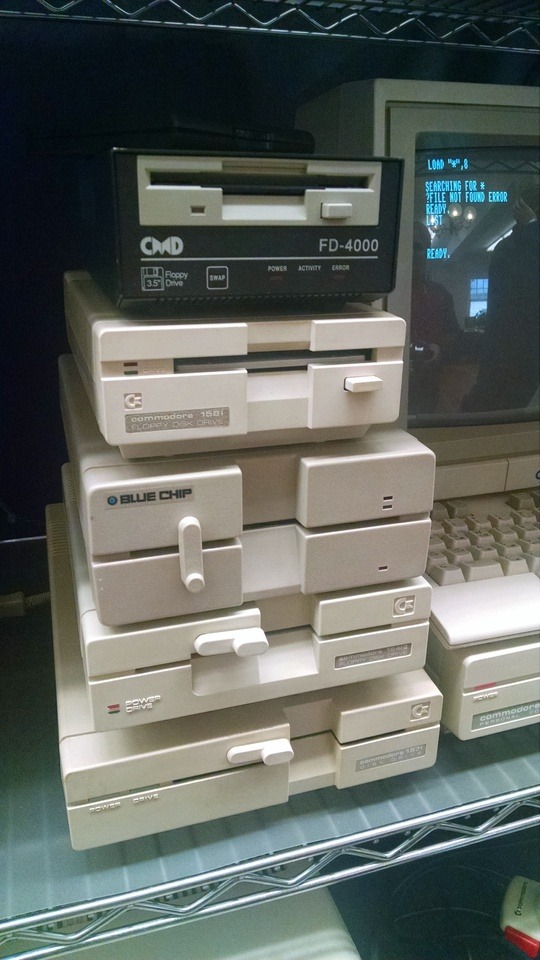
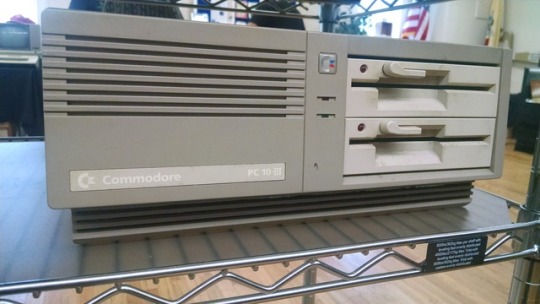
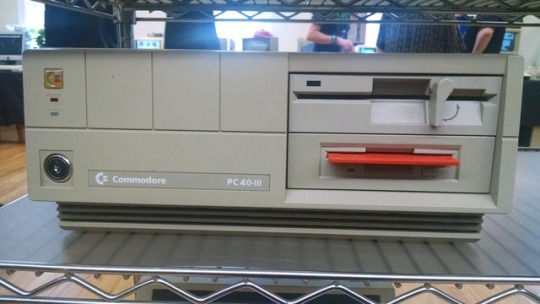
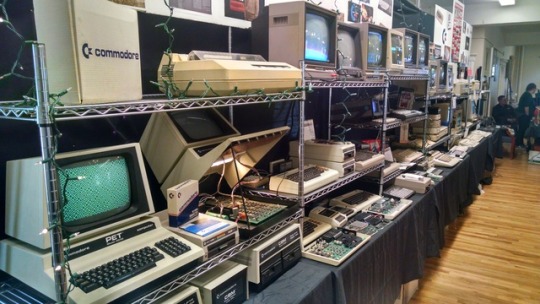
Commodorians Part 4
This was one of the three mega exhibits for the 40th anniversary of the big three appliance computers launched in 1977. Anthony Becker, Jeffrey Brace, Chris Fala, Todd George (captain), & Bill Winters combined their skills, collection, and love for Commodore equipment to showcase the PET-2001′s family tree.
Commodore launched the Amiga line in 1985, and with it a whole new breed of computer geek was born. A powerhouse multimedia computer that was outclassing the graphics and sound capabilities of any competing home computers, the Amiga series was sold until the company’s demise in 1994.
Anthony Becker & Bill Winters brought their sizable Amiga collection, spanning the full series starting with the Amiga 1000. The real sales powerhouses were the Amiga 2000 and its less expensive, less expandable counterpart, the Amiga 500. The 1200, 3000, 4000, and CD32 rounded out the bunch, showing what was happening in the final days at Commodore. The CD32 in particular has some amazing games and demos to show the kind of graphics it could produce.
If I asked what machine was considered the heir to the Commodore 64′s throne, what would your answer be? The C128, with full backwards compatibility and features bursting out of the seams? The Amiga 500, filling a similar niche as an inexpensive, graphically capable gaming machine? There was a different heir apparent in the works that never saw full production...
The real gem of this display was the prototype machine from 1990/91: the Commodore 65. 8-bit development was passe, everyone else was focusing on new Amiga machines to fill out the various market niches. Then some guy in who didn’t really work well with anyone else was working on the Commodore 65.
It included an internal 1581 3½ floppy drive, a keyboard not all that dissimilar from the C128′s, 128K of RAM stock, expandable to 8MB, 4096 possible colors, a 320x200 256 color mode, and a 1280x400 16 color mode. It used the CSG 4510 processor, running at 3.54MHz. This machine never left the prototype stage, but a handful of Commodore 65′s have made their way to collectors over the years. No software exists for the machine, so it doesn’t have anything to show off besides some disks of unfinished demos, and a rainbow boot screen.
Speaking of the 1581, the exhibit had an impressive drive tower. Stacked drives included the 1571, 1541-II, 1581, aftermarket Blue Chip drive, and CMD FD-4000. Commodore fans seem to like making drive towers, and I completely understand this fascination.
While it doesn’t get talked about much, Commodore did make IBM PC compatibles for a few years. The PC 10-III and the PC 40-III were on display, in full Commodore livery but with x86 compatibility under the hood. Sadly, neither of these oddities were demonstrated.
#VCF East XII#vintage computer festival east xii#commodorez goes to vcfexii#vcfexii#vintage computer festival east#commodore#commodore 64#commodore 65#c65#amiga#amiga 1000#commodore amiga#amiga 2000#amiga 3000#amiga 4000#amiga 500#amiga 1200#amiga cd32
289 notes
·
View notes
Photo
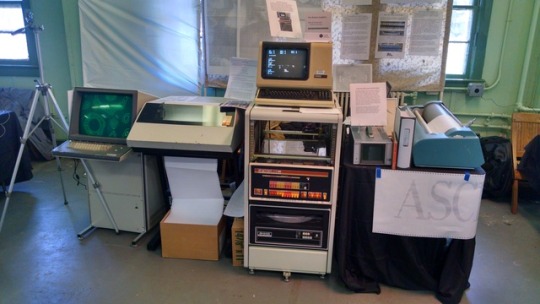
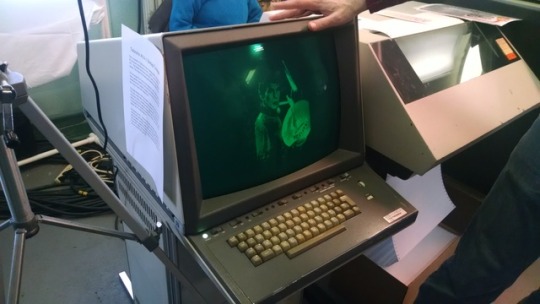


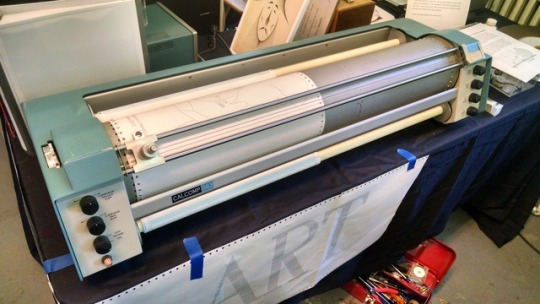
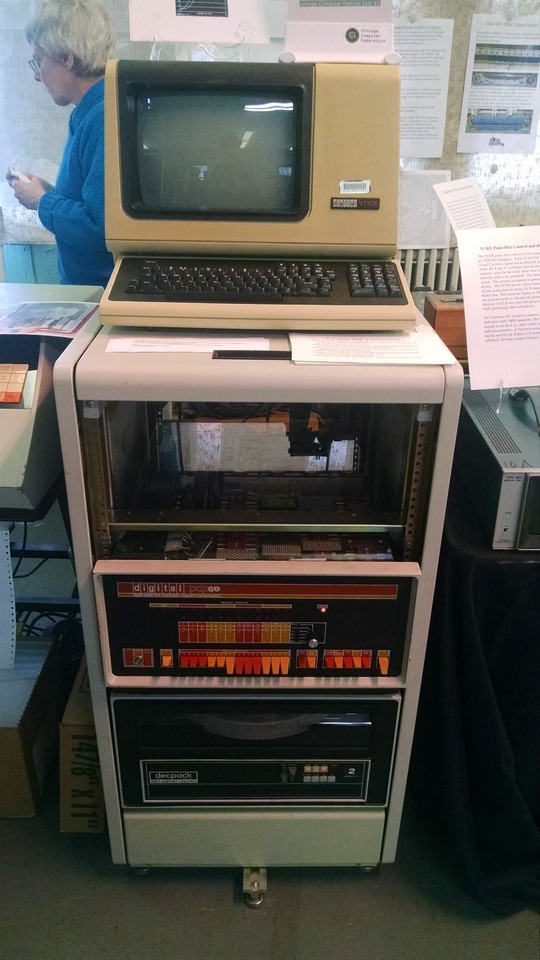
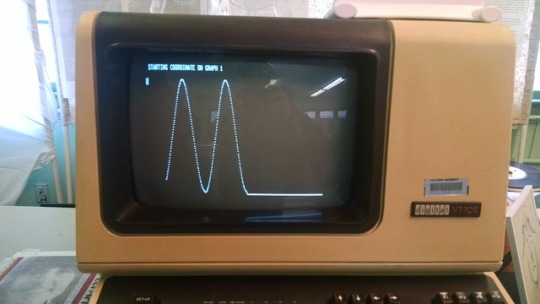


Pre-Raster Graphics
David Gesswein is considered to be one of the reigning experts in DEC’s PDP-8. Almost every time I’ve been to a VCF East, David is there with a PDP-8 of some kind, usually an 8/e, and this time was no exception. He took portraits with a modern camera, then converted them to ASCII and printed them out on a large, beautiful, dot-matrix printer -- I plan on framing mine!
There was also a Tektronix 4014 showing just how much resolution the 1970s had to offer (if only in monochrome). Brian Stuart, who had the exhibit on Forth, borrowed this terminal to test one of his programs on the authentic piece of kit and it was beautiful. If I understand correctly, unlike other terminals of the era, Tektronix graphical terminals had on-board storage to keep images locally. You’ll note the bank of circuit boards that sat in the cabinet under the CRT to facilitate storage and precision graphical rendering.
Lastly, David had a really cool Calcomp 563 plotter drawing really cool artwork, one line at a time. Makes me want a plotter...
“Multiple graphics technologies will be exhibited that were common before raster graphics won. See 4K graphics on a 1970s Tektronix 4014 vector storage terminal. Have your picture taken by a PDP-8 computer and printed on a 200 line-per-minute chain printer in glorious ASCII art. See a pen plotter operate.”
#vintage computer festival east xii#commodorez goes to vcfexii#VCF East XII#vcfexii#vintage computer federation#pdp-8#pdp 8#pdp-8/e#digital equipment corporation#digital#DEC#plotter#tektronix graphics mode#tektronix
308 notes
·
View notes
Photo
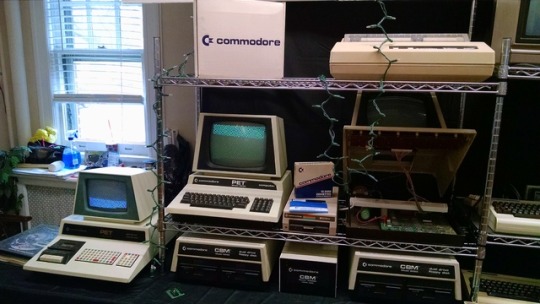
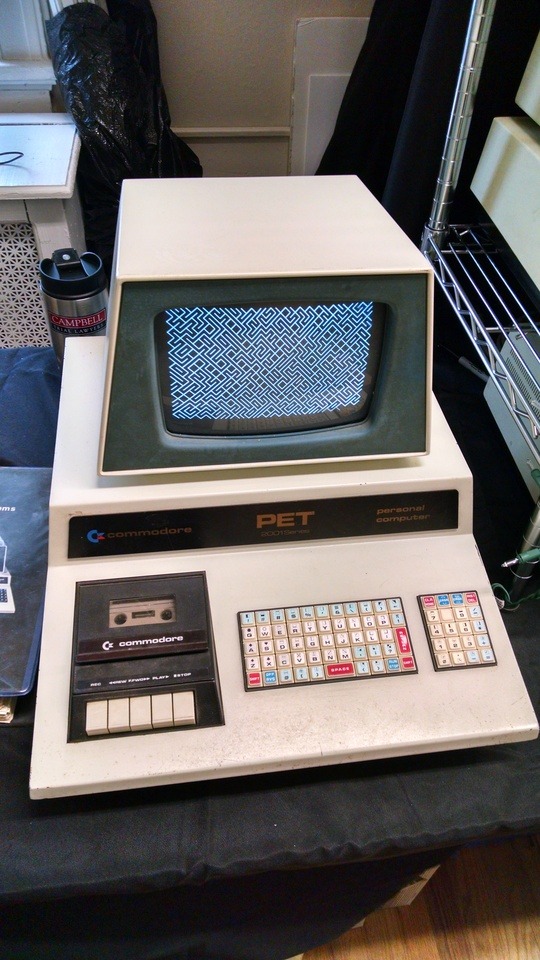
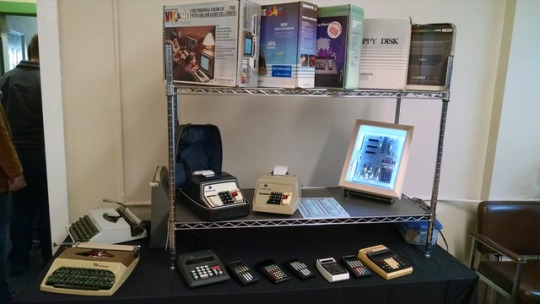

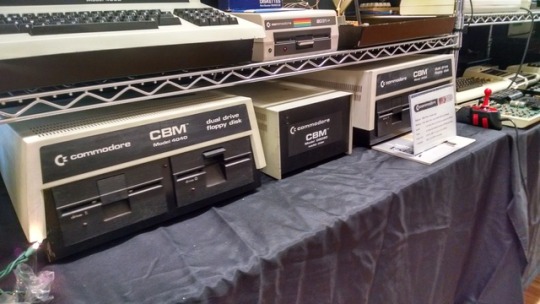
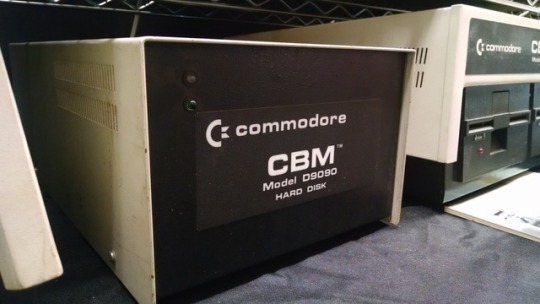
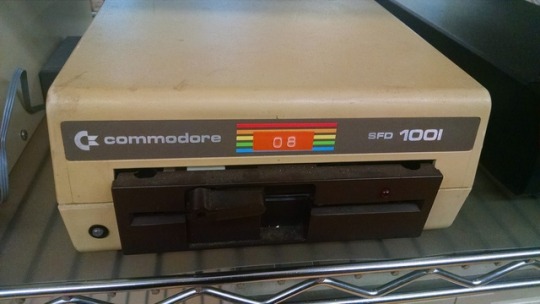
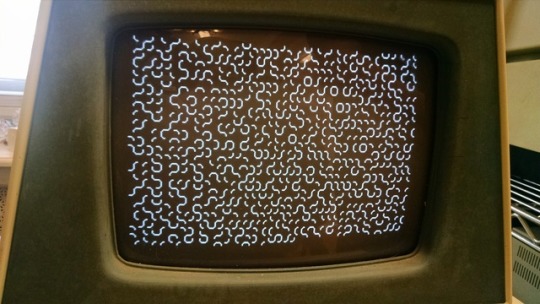

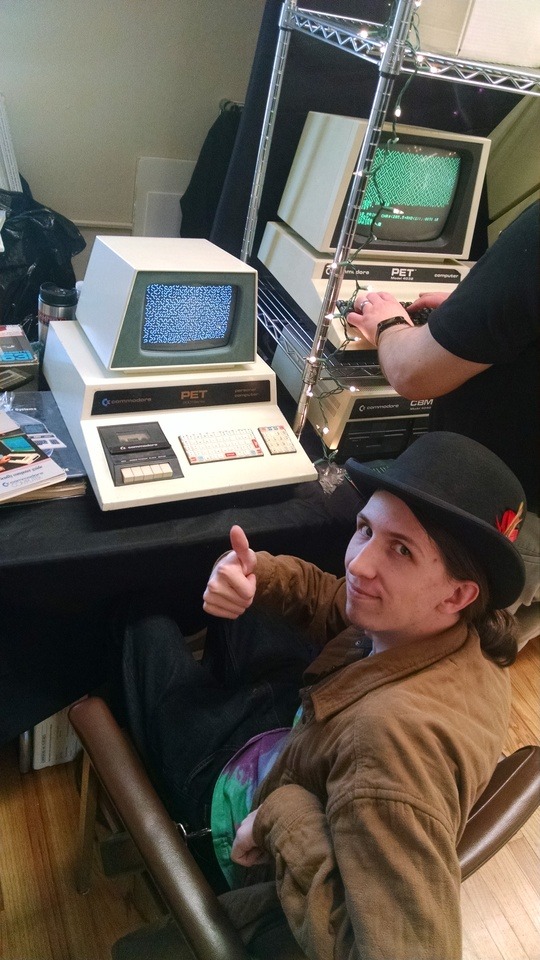
Commodorians Part 1
This was one of the three mega exhibits for the 40th anniversary of the big three appliance computers launched in 1977. Anthony Becker, Jeffrey Brace, Chris Fala, Todd George (captain), & Bill Winters combined their skills, collection, and love for Commodore equipment to showcase the PET-2001′s family tree.
Before Commodore Business Machines was making computers, they were making office equipment, namely typewriters. They got into the game of manufacturing adding machines, followed by calculators which were constantly decreasing in size while improving their capabilities. During the calculator wars, Texas Instruments had an upper hand in the market by being a main source of calculator integrated circuits. In an attempt to subvert TI’s control, Commodore purchased MOS Technology so they could produce their own semiconductors in house.
It just so happened that MOS had a microprocessor, the now famous 6502, which they were using in the KIM-1 trainer./demonstrator. Commodore continued selling the KIM-1 with their own branding, and one was on display acting as a clock.
However, the 6502 really shined in their first home computer, the PET-2001, available initially in an 8K version and a short lived 4K version. The PET was unique compared to its contemporary appliance home computers (the Apple II and TRS-80 Model I) in that it included a monitor and tape drive all in the same chassis. You’ll also note that the case of the 2001 is made from metal, not plastic like the competition. In true Commodore fashion, this was a money saving move -- they re-purposed their file cabinet manufacturing arm to make cases for the PET line resulting in very sturdy cases. The keyboards were re-purposed from cash registers, resulting in an incredibly clunky and uncomfortable design that didn’t last long.
I made it a personal mission to sit down at the PET-2001-8, just as I had at my first VCF East a decade ago, and program something. I tweaked the existing random character generator program on screen to use different PETSCII graphics than the demonstrator they had set up. This is an early blue bezel model, which makes up for the terrible chiclet keyboard.
The PET-2001 was succeeded by the 4000 and 8000 series machines, boasting larger screen options, a proper full travel QWERTY keyboard, more memory, better external interfaces, and more advanced versions of Microsoft BASIC. The IEEE-488 interface was fully implemented by this point, and was used with larger storage mediums like the 4040 and 8050 dual floppy drives, and rare CBM D9090 hard disk drive. The real oddity here is the very late SFD1001 drive, which uses the IEEE-488 parallel interface, but crams it into the case of a later 1541 drive more synonymous with the C64.
#VCF East XII#commodorez goes to vcfexii#vcfexii#vintage computer festival east xii#vintage computer fesitval east#Commodore PET 2001#PETSCII#pet 2001#Commodore#pet 2001-8#KIM-1#PET-4032#PET 4032#commodore pet 8032
149 notes
·
View notes
Photo
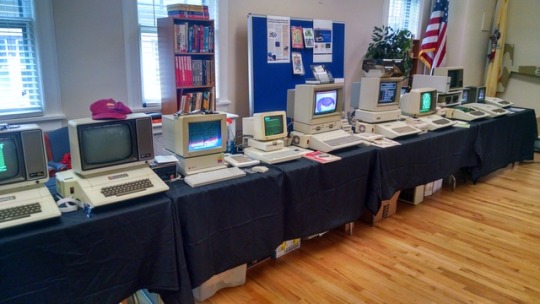
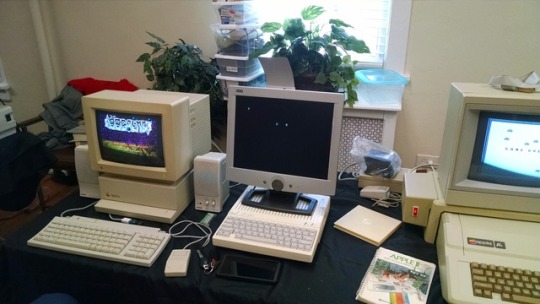
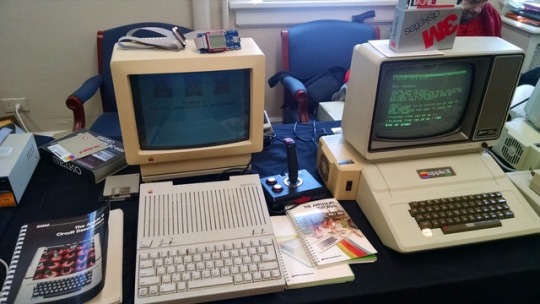
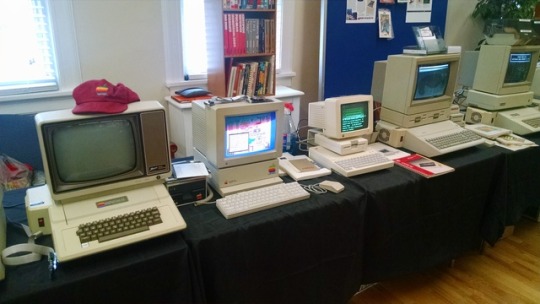
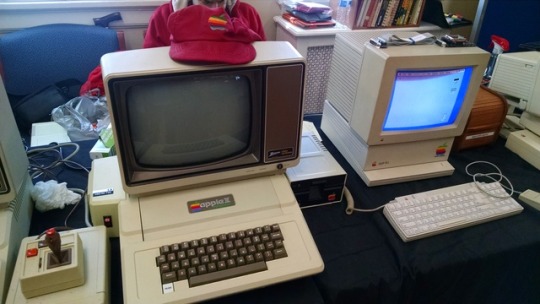
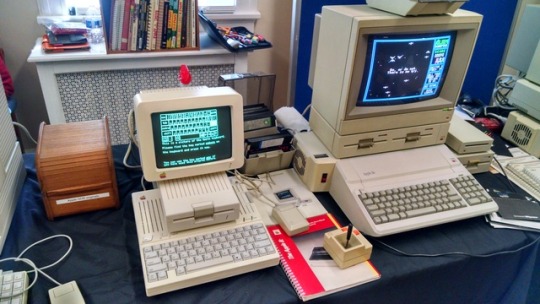
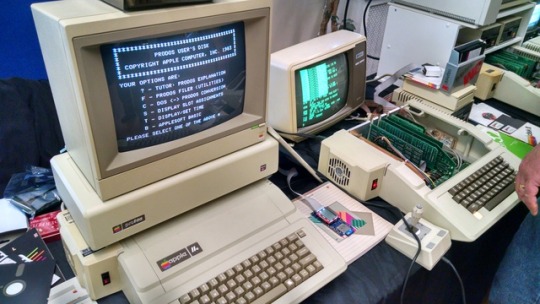
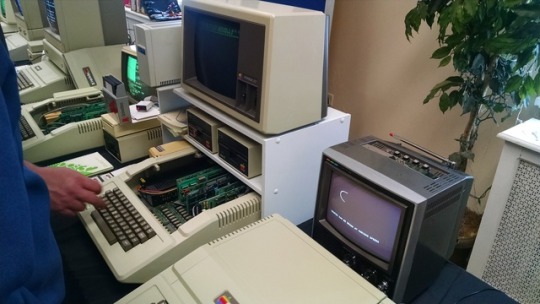
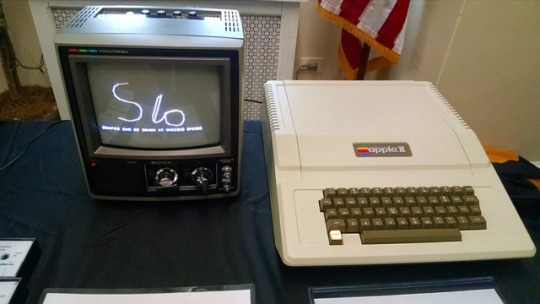
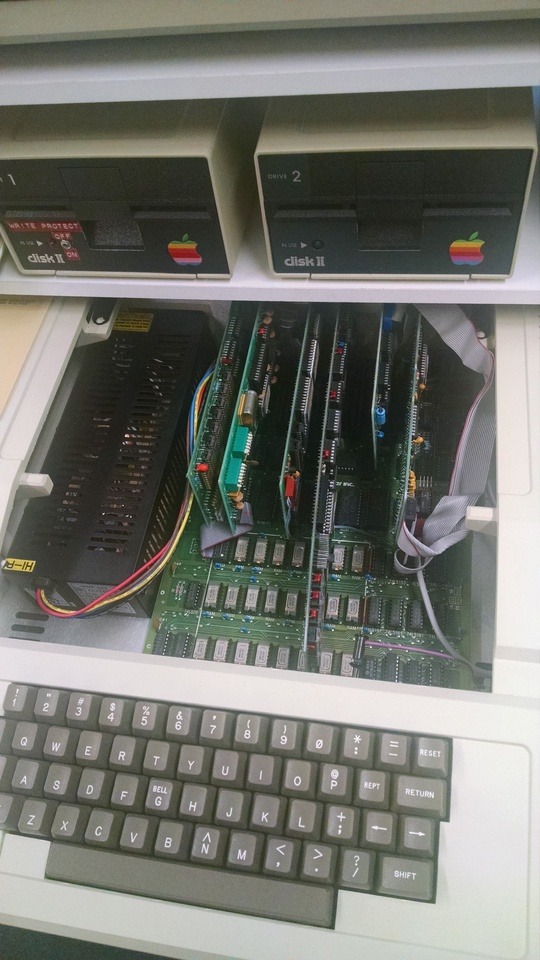
AppleDappleDudes
This was one of the three mega exhibits for the 40th anniversary of the big three appliance computers launched in 1977. Tony Bogan (captain), Corey Cohen, Mouse Kelly, Adam Michlin, & Joseph Oprysko worked together to show the Apple II in all its glory.
An original Apple II, followed by II+, IIeuroplus, IIe, platinum IIe, IIc, IIc+, IIGS. I don’t have alot to say about this one, but I think they covered the lineage pretty effectively.
They also had an Apple I on display, but I will get to that in tomorrow’s post.
#vintage computer festival east xii#VCF East XII#commodorez goes to vcfexii#vcfexii#vintage computer festival east#apple#apple ii#apple iie#apple ii+#apple iic#Apple IIGS
192 notes
·
View notes
Photo
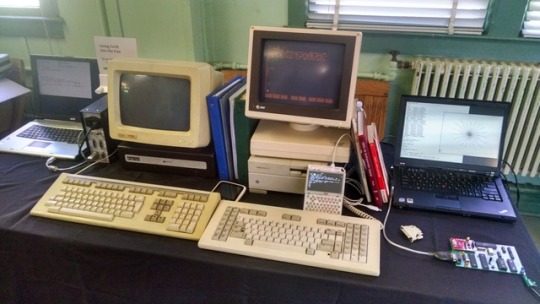

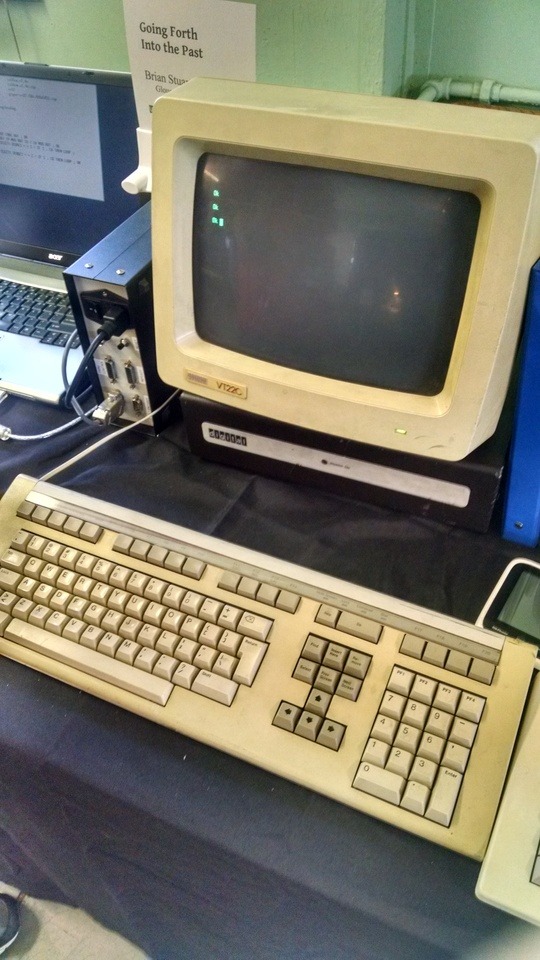
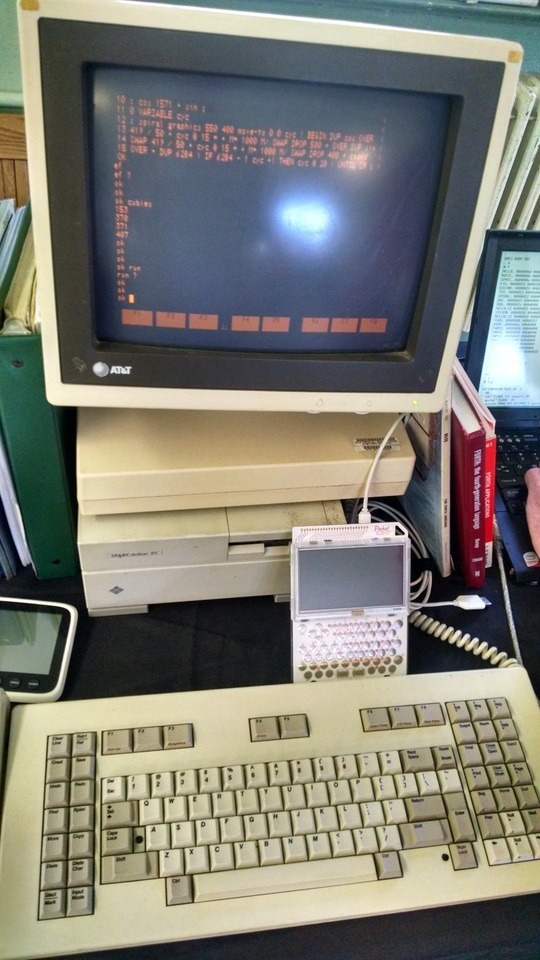
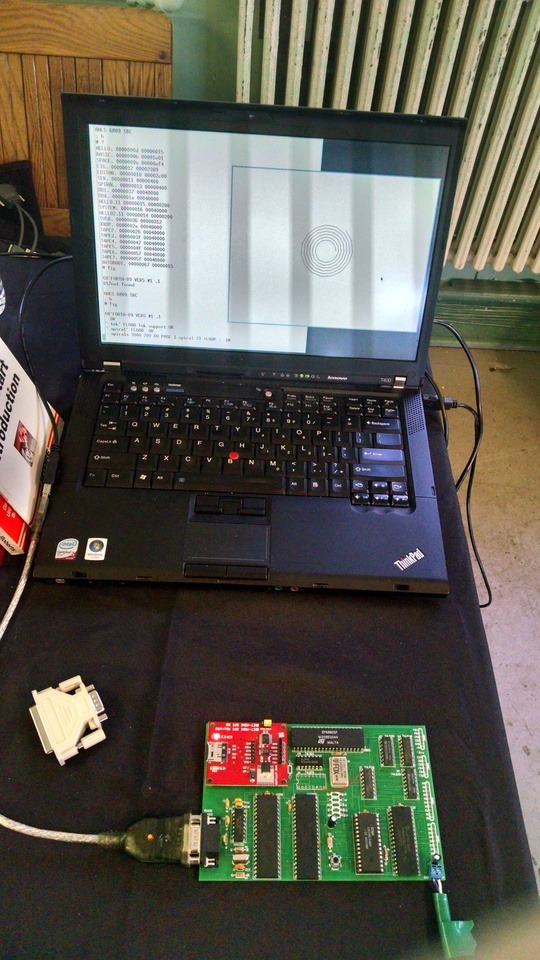
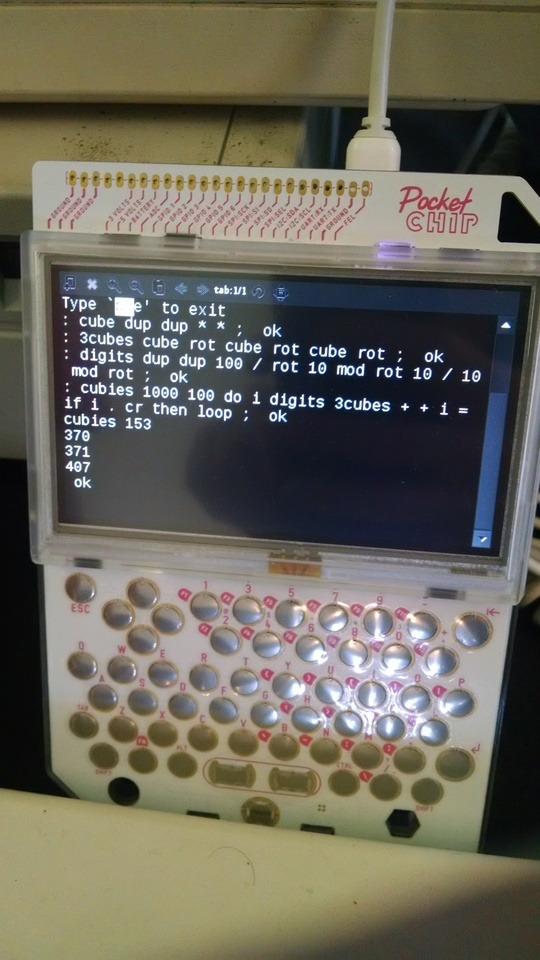
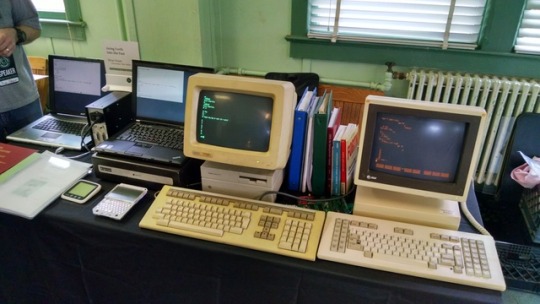
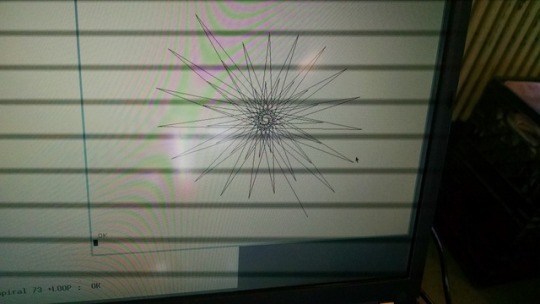
Going Forth Into the Past
You want to find a higher level language that’s really easy to port to various architectures spanning about 50 years? Brian Stuart has you covered with the classic language Forth. Brian even implemented it himself for his LSI-11 (basically a PDP-11/03 on a chip) back when he was in college, and decided to dust it off for the first time in decades just for VCF East. He also had a 6809 based SBC, a SPARC Station, and the Pocket Chip arm based machine. You name it, Forth will be there. He even was emulating a Tektronix graphics terminal on his laptop, drawing spirograph-like images using Forth -- he later got to test it on the real thing.
“In the late 1960s Charles Moore developed the Forth programming language as a tool for efficiently developing control systems. Ever since, it’s found application in domains ranging from tiny embedded systems, to monitoring sorting belts at FedEx, to implementing workstation consoles, to controlling large telescopes, to controlling large laser arrays doing fusion research. Like LISP before it, Forth developed an avid following of programmers who understood how to use it as a meta-language for creating application specific languages customized to the problem at hand. It has a direct connection to the theory of Turing completeness and is one of the simplest languages to implement. This exhibit celebrates this amazing language by demonstrating several different implementations of Forth on a variety of hardware, all accompanied by educational material to help the viewer understand that concepts behind the language.”
#VCF East XII#vcfexii#commodorez goes to vcfexii#vintage computer festival east xii#vintage computer festival east#forth#pdp 11#lsi 11#pocket chip#6809#sparc#digital equipment corporation#tektronix graphics mode
187 notes
·
View notes
Photo
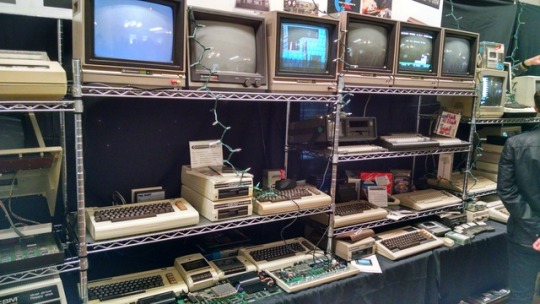

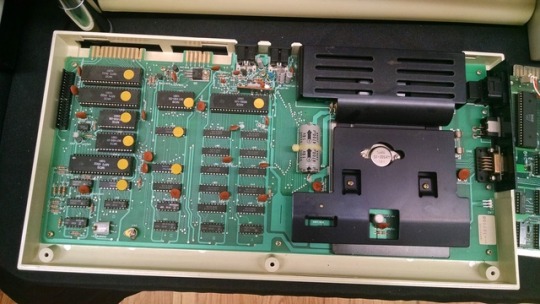
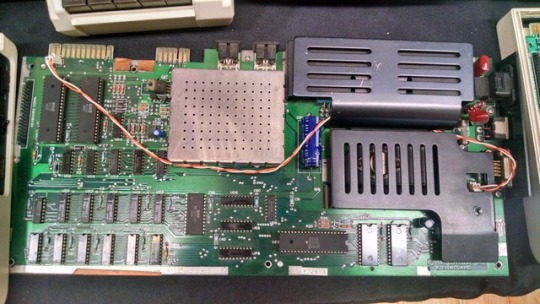
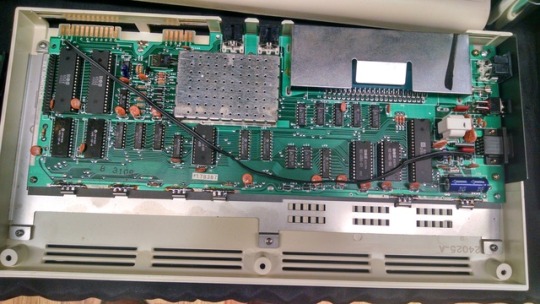
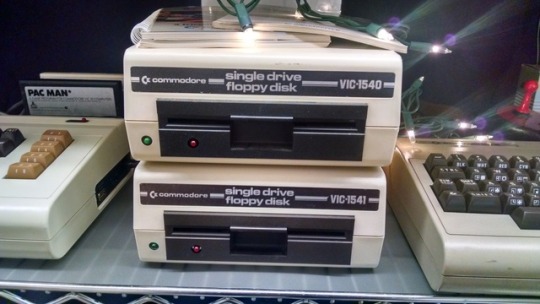
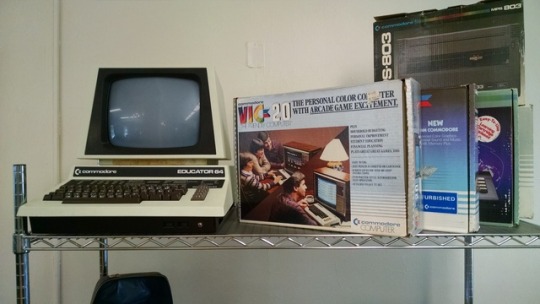
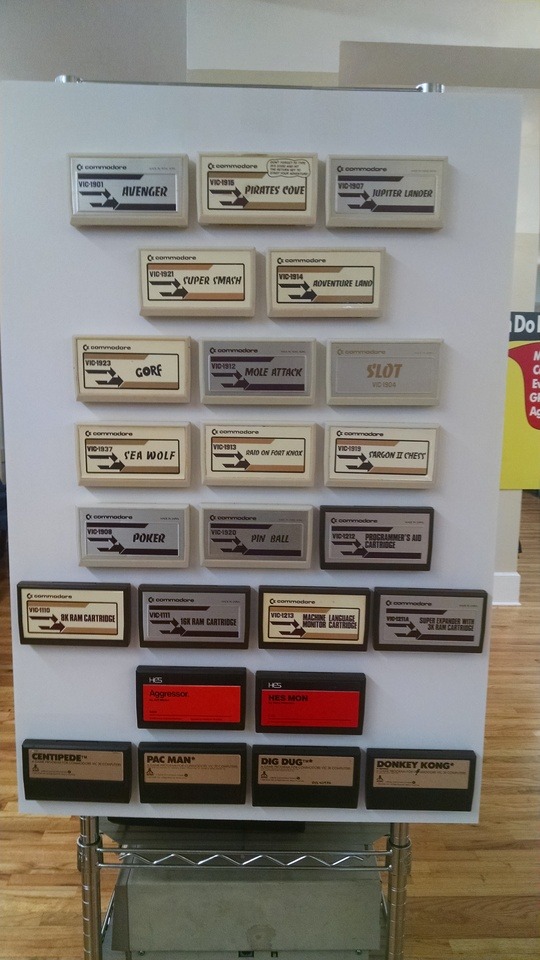
Commodorians Part 2
This was one of the three mega exhibits for the 40th anniversary of the big three appliance computers launched in 1977. Anthony Becker, Jeffrey Brace, Chris Fala, Todd George (captain), & Bill Winters combined their skills, collection, and love for Commodore equipment to showcase the PET-2001′s family tree.
Commodore’s PET/CBM series wasn’t exactly geared towards computer users on a budget, nor did any of them have color graphics modes, or a wide variety of games. Then in 1980, the VIC-1001 was released in Japan in an attempt to corner their home computer market before anyone else. However, it didn’t take too well to the Japanese market, and Commodore never succeeded there.
However, the American version known as the VIC-20 was wildly successful. In 1981, a VIC-20 could be purchased for under $300 which was incredibly inexpensive for a color home computer. The downside was that the VIC-20 only had a 22 column display, and 5K of RAM, of which only 3583 bytes were available to the user.
The VIC-20 was the first computer to break a million units sold. In true Commodore fashion, they saved money wherever possible by changing the design to decrease production costs, resulting in three main variations.
Early models that lacked RF shielding around the VIC-I graphics chip and a massive heat sink
Models with RF shielding and a massive heat sink
Late, cost-reduced models with denser RAM chips, improved power regulation, no massive heat sinks, and smaller motherboards
The VIC-20 introduced the serial IEEE-488 bus designed to replace the older parallel version, so as to save money on disk and printer interfaces. The first disk drive to use this interface was the short-lived VIC-1540 drive. Due to the way serial was implemented, the 1540 only works with the VIC-20. It was replaced with the VIC-1541, which was later branded the 1541 and continued to be used with the majority of the Commodore 8-bit line. Because of its short production run and lack of general compatibility, the VIC-1540 has become somewhat of a collectors item. This one was on loan to the team, and its functional status was unknown.
Most software distributed for the VIC-20 came on cassette tape, as well as on ROM cartridges that plugged into the back of the machine.
The PET line wasn’t seeing as much of the spotlight by this point for Commodore -- the C64 had taken center stage by 1982. Internally, a C64 uses far fewer components than any PET model, so to save money they put a C64 motherboard and keyboard in a PET case, and called it the Educator 64. They never bothered to put a color CRT in there though, so the VIC-II chip’s 16 colors never get a chance to shine.
#VCF East XII#commodorez goes to vcfexii#vintage computer festival east xii#vcfexii#vintage computer festival east#commodore#vic-20#Commodore VIC-20#vic 20#vic-1540#vic-1541#educator 64
79 notes
·
View notes
Photo
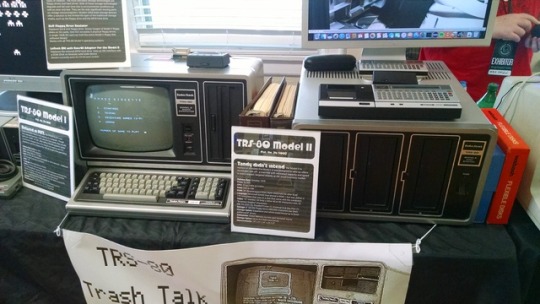
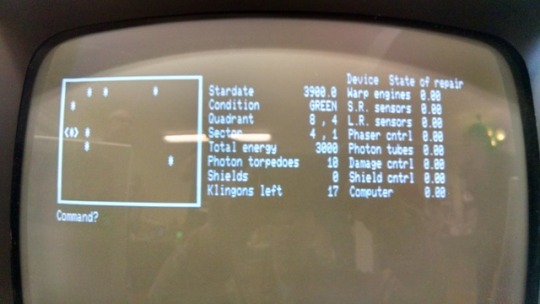
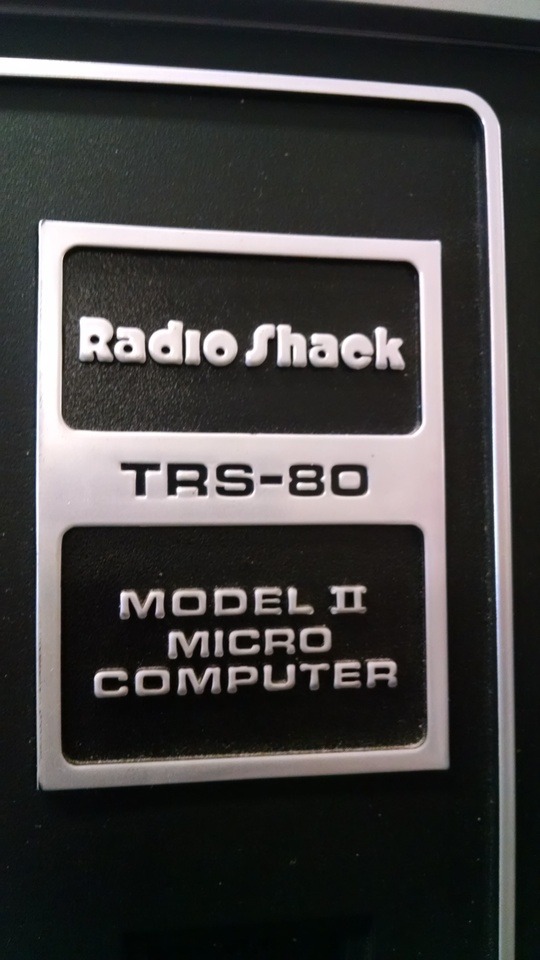
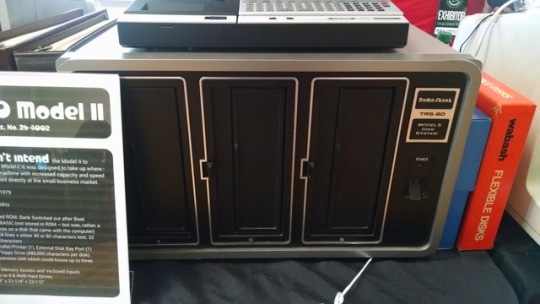
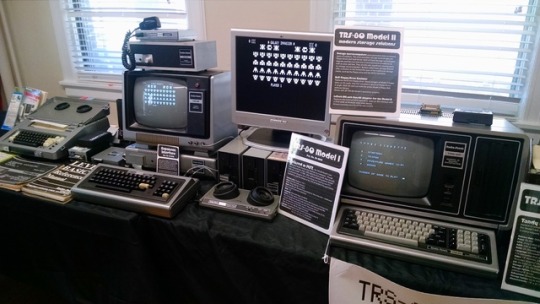
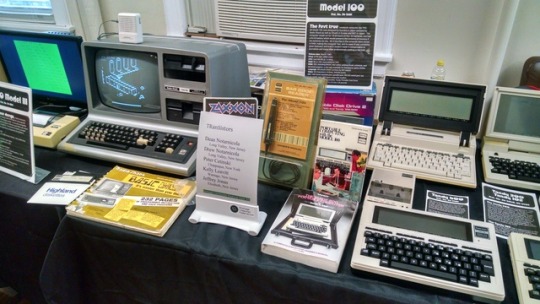
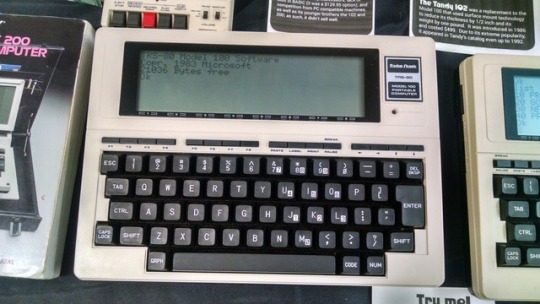
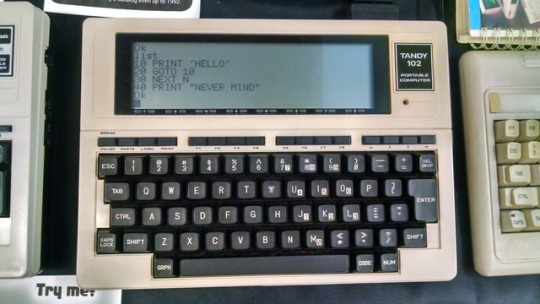
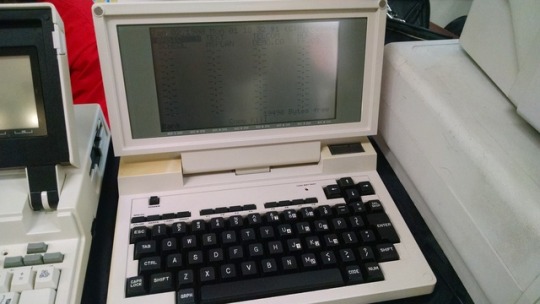
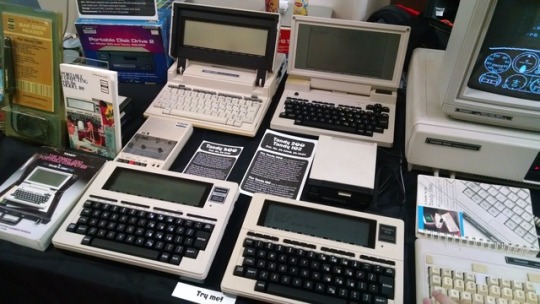
TRanSistors Part 2
This was one of the three mega exhibits for the 40th anniversary of the big three appliance computers launched in 1977. Peter Cetinski, Kelly Leavitt, Dean Notarnicola (captain), his son Drew Notarnicola, & Jeffrey Jonas teamed up to display Tandy Radio Shack computers, primarily focusing on the TRS-80.
Seen here is the rarely talked about TRS-80 Model II, which was designed as more of a business machine than a personal machine. This means that Tandy gave this machine a 4MHz Z-80A, 32K or 64K of RAM, the largest external storage mediums available, and a 12″ monitor -- nothing to sneeze at in 1979.
It included an internal 8″ floppy drive, but it was common to see it with a hulking bank of three external 8″ drives. It isn’t common to see a model II running, but this is VCF East, and it’s no fun to display a broken computer. I played Star Trek on it, however it was loaded from a modern CF card storage device instead of the original 8″ drives (which are apparently incredibly frustrating to fix). I also played Worms, which was a pretty good snake game, even with the awkward controls.
While they weren’t architecturally similar to the desktop Trash-80 machines, the TRS-80 Model 100, 102, 200, and even 600 series portable machines were a big hit. A precursor to the modern laptop in terms of portability, these devices had full keyboards that would put many modern machines to shame. The down side to this design was the limited character display, lacking a backlight or any serious graphics modes. I still want one...
Stay tuned for the final installment of TRS-80′s tomorrow.
#vintage computer festival east xii#commodorez goes to vcfexii#VCF East XII#vcfexii#vintage computer festival east#TRS80 model II#TRS-80#trs-80 model 1#trs-80 model 100#trs-80 model 102#trs80
94 notes
·
View notes
Photo

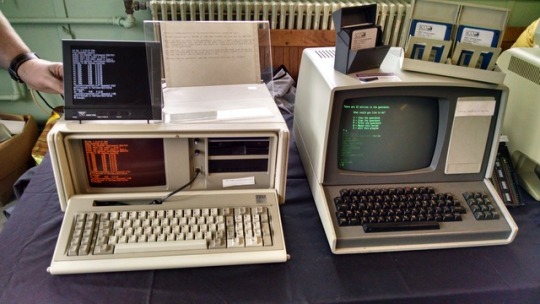
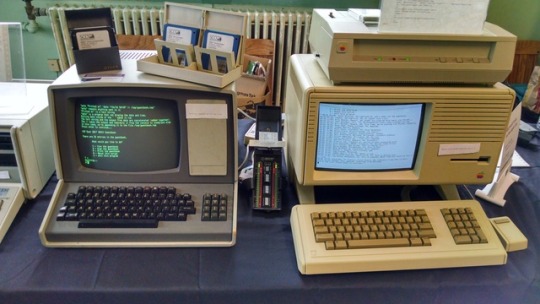

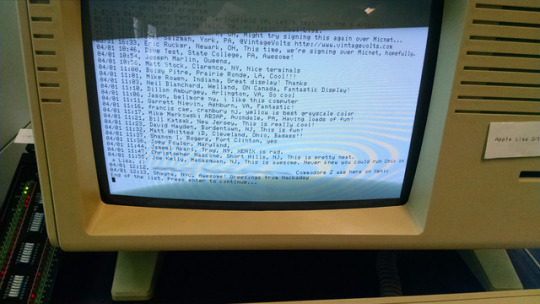
Microsoft Xenix on the Apple Lisa
When people mention Microsoft and Unix in the same sentence, they usually are talking about their pros and cons for various deployments. However, 1980, Microsoft made its very own flavor of Unix, which ended up not being as big of a hit as they had hoped. Still, it’s a fun curiosity which Jason Perkins & Eric Rucker decided to explore on an Apple Lisa 2, an IBM 5155 PC portable , and a Zenith Z19 connected to the Lisa.
Together, both main machines ran a fun guestbook program that was synchronized over serial by way of a cron job. Of course, I entered my name into the guestbook by way of the Z19
On Sunday of VCF East, someone (who I never caught the name of, on the left), programmed up a bitmap viewer on the Lisa, while Jason (center) & Eric (right) converted and transferred a file onto its hard drive. Apparently converting their cellphone photo to a suitable type for the Lisa, and getting it there took several hours of trial and error. The results were pretty spectacular though!
#VCF East XII#vcfexii#commodorez goes to vcfexii#vintage computer festival east xii#vintage computer festival east#xenix#microsoft xenix#apple lisa#lisa 2#ibm pc portable#ibm 5155#zenith z19#z19
112 notes
·
View notes
Photo
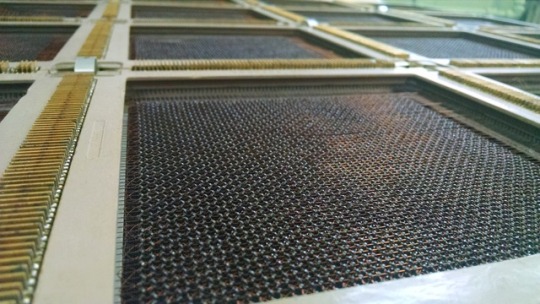
Core memory from an AN/FSQ-7 of the SAGE defense system. Beautiful.
#sage#an/fsq-7#ibm#semi automatic ground environment#vcf east xii#vcfexii#commodorez goes to vcfexii#vintage computer festival east xii#vintage computer festival east#core memory
208 notes
·
View notes
Photo
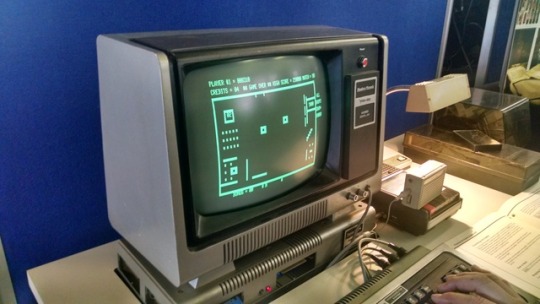
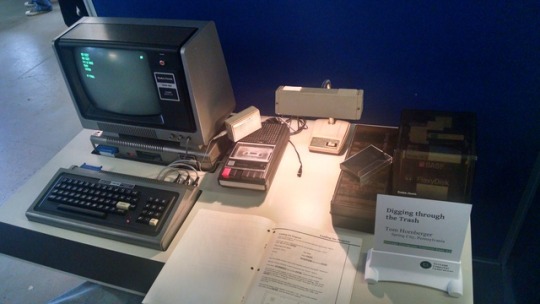
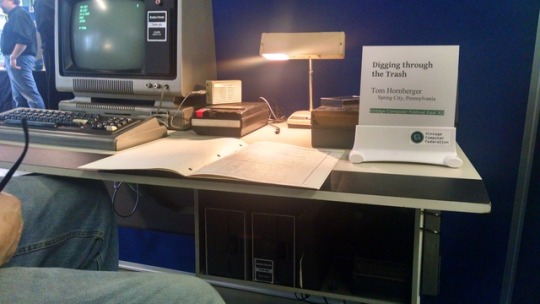
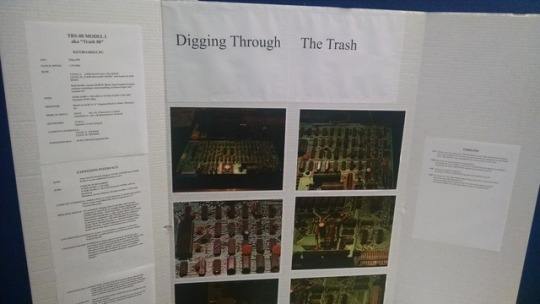
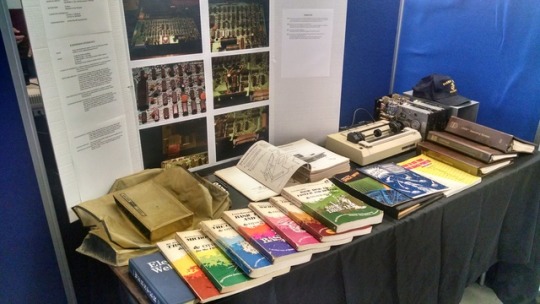
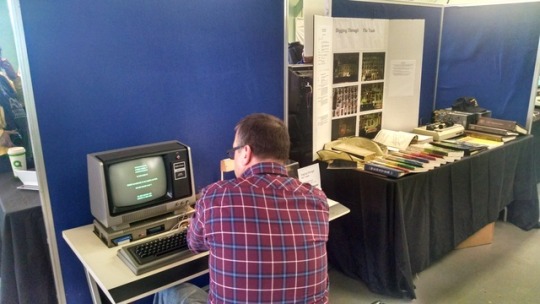
Digging through the Trash
Of the big 3 home computers to be celebrating their 40th anniversaries at VCF East XII, Tom Hornberger put together quite possibly the single most authentic recreation of a home deployment you could imagine. I would dare call this a shrine to Tandy Radio Shack’s TRS-80 Model I, as you would have encountered one in 1977.
Seen here is a TRS-80 Model I in a specially built desk with an inset for the main unit/keyboard, a second inset for the expansion unit and monitor, and a little shelf underneath for the bank of 5¼ floppy drives. Tom brought along an authentic tape deck, Radio Shack pocket amplifier, and even a tiny era-appropriate desk lamp! Documentation, a printer, and software galore shows he was a hardcore TRS-80 user when this was new and commonplace in the home, and Tandy was king of microcomputer sales (if only for a few years).
I learned more about the TRS-80 talking to Tom than I have in all my years in this hobby.
#VCF East XII#commodorez goes to vcfexii#vcfexii#vintage computer festival east xii#vintage computer festival east#trs 80#trs 80 model i#tandy#tandy radio shack#trash 80
127 notes
·
View notes
Photo
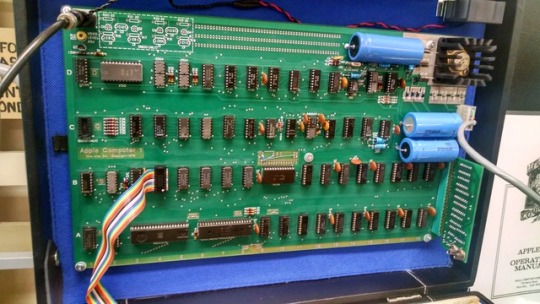
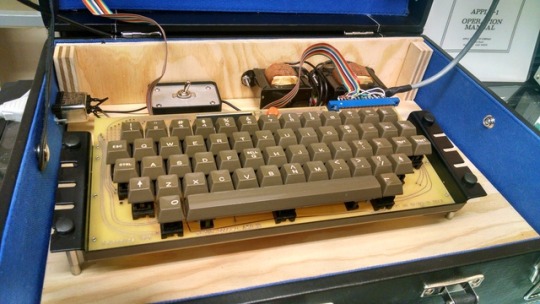

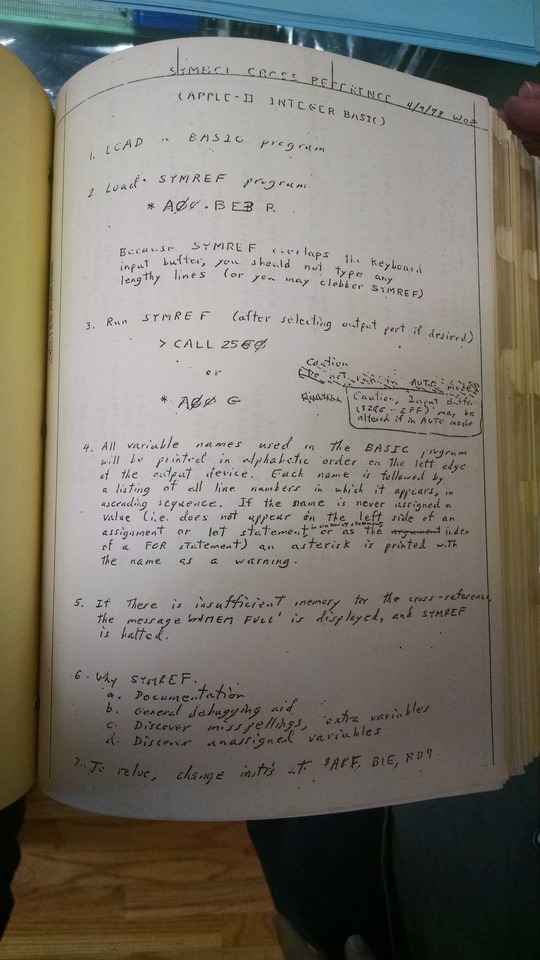
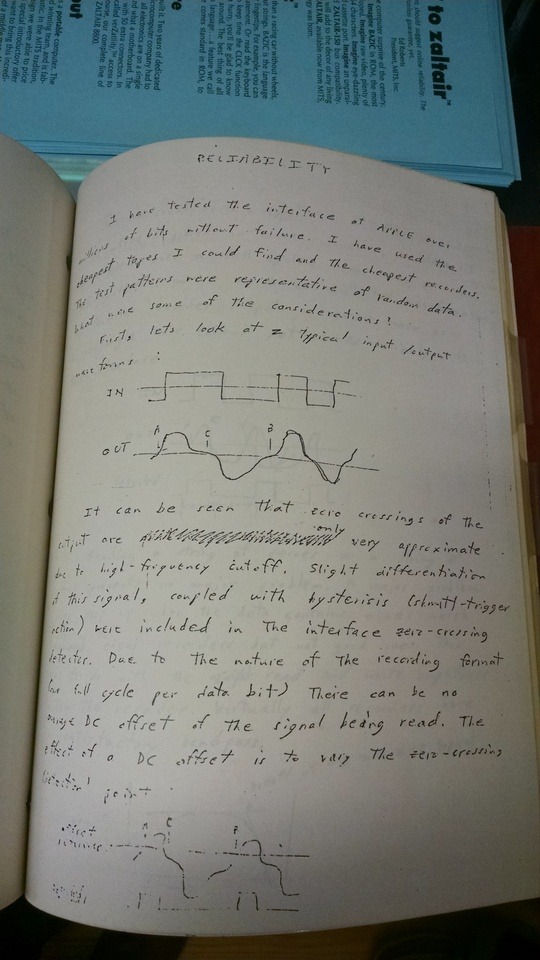
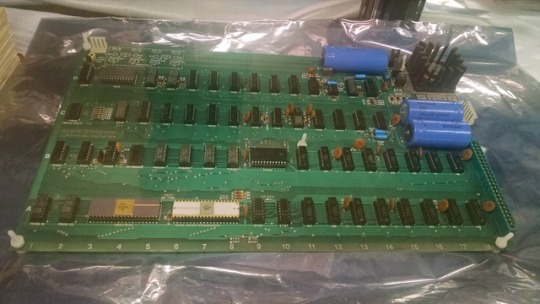
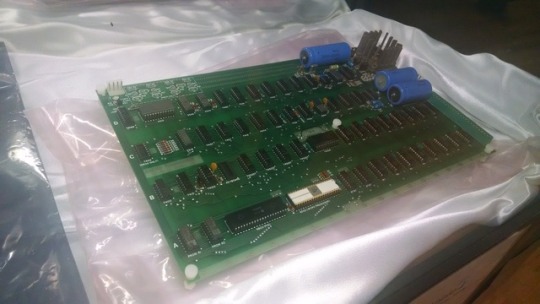
AppleDappleDudes Part 2: Apple I for the win!
Corey Cohen, the reigning expert on Apple I’s (aside from Steve Wozniak himself) brought not one but two authentic Apple I computers in for display. In order to give visitors a hands-on approach, he also brought in a replica suitcase implementation complete with little black & white monitor.
Corey happens to have an early copy of the Apple I manual, which was photocopied from Wozniak’s hand-drawn master copy notes and instructions. Seen here is a page about loading Integer BASIC, and another about cassette deck operation. It’s incredibly informal, but shows the inner machinations of Woz’s mind when he was designing his first computer.
Oh, and then they let me hold one. So that was cool. Look at that beautiful white ceramic & gold MOS 6502.
#VCF East XII#commodorez goes to vcfexii#vintage computer festival east xii#vcfexii#vintage computer festival east#apple#apple i#steve wozniak#woz#wozniak#commodorez
65 notes
·
View notes
Photo

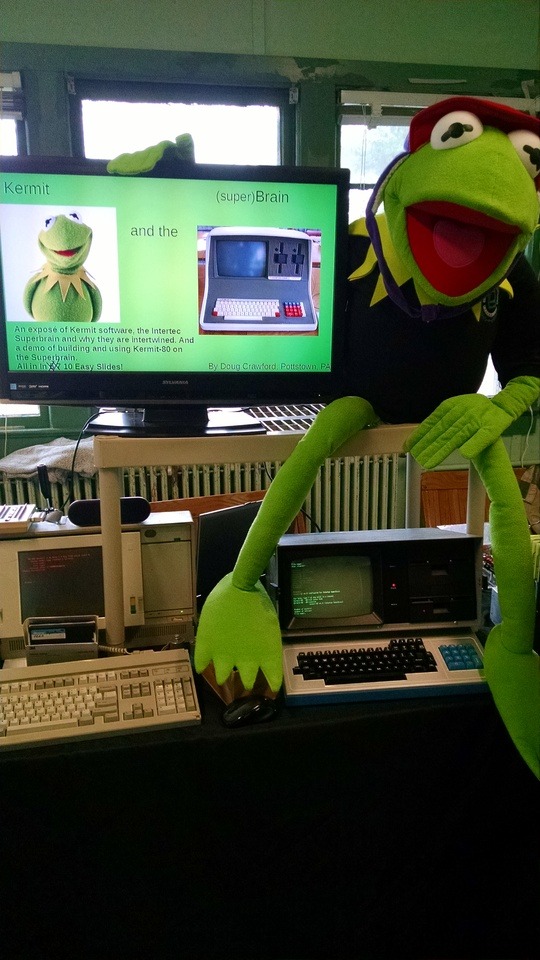

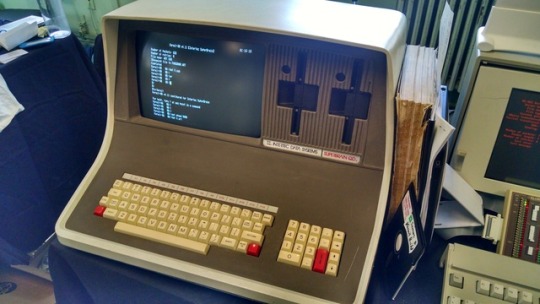
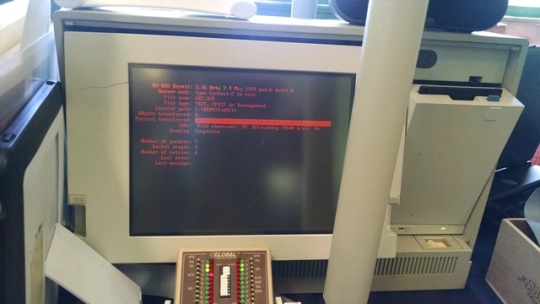
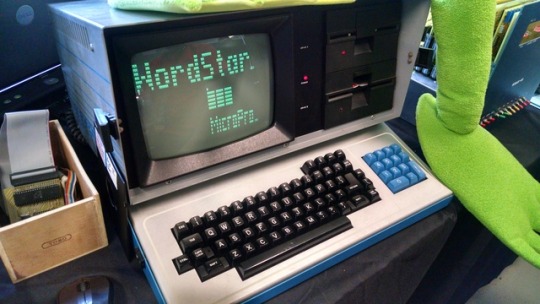
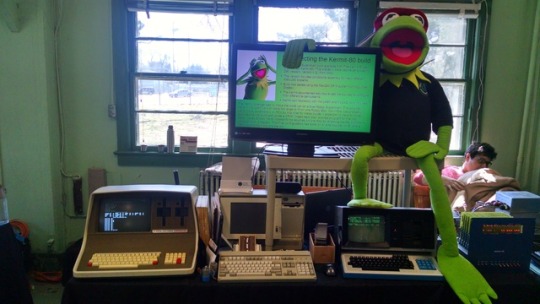
Kermit and the Brain
It’s the mid 1980s. You have a file want to transfer from one computer to another, but these machines are vastly different. Both have RS-232 serial. That might help, but you have no common protocol to transfer that file.
A frog comes to your rescue.
Seriously though, the Kermit file transfer protocol is one of the most widely ported piece of software out there -- and for good reason. Douglas Crawford explored the ubiquitous transfer protocol on two CP/M capable machines, and an IBM PS/2 luggable running MS-DOS. The Kaypro II machine is plenty common, but the Intertec Superbrain (another Z-80 based machine which ran CP/M) is a recently restored gem. Douglas demonstrated the compile time of the 8080 build of Kermit on his Superbrain, which didn’t take much time at all. Then he transferred some files from the IBM over to the Superbrain like it was nothing. The best part i that Kermit is still a viable data transfer method today when moving information to and from legacy machines.
“This exhibit shows the Intertec Superbrain and its historical role in file transfer technology. In 1981 Columbia University pioneered the application of microcomputers for enabling students to transfer their minicomputer and mainframe work files to and from their own personal floppy disk storage. The first client version of Kermit was implemented on the Intertec Superbrain. From that point Columbia University fostered a grand project that spread Kermit to nearly every execution platform in existence. It might be said that our downloads and uploads we do today over the Internet owe some respect to the Superbrain in its first file transfer to floppy. This exhibit will include: a Superbrain QD computer recently restored to operation, highlights of the restoration effort, unique aspects of the Superbrain’s design, the Superbrain’s role at Columbia University as the first Kermit client platform, period development tools, and a build of an early Z-80 assembler version of the Kermit client that I’m making. It will also demonstrate Kermit file exchange using the Superbrain and possibly running the “built” Kermit client along with a presentation of noteworthy Kermit details, history, and its significance to today.”
#VCF East XII#vcfexii#commodorez goes to vcfexii#vintage computer festival east xii#vintage computer festival#kermit#intertec superbrain#intertec#superbrain#kaypro ii#ibm ps/2#plasma screen
80 notes
·
View notes
Photo
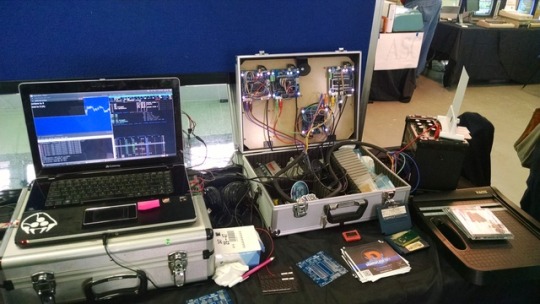
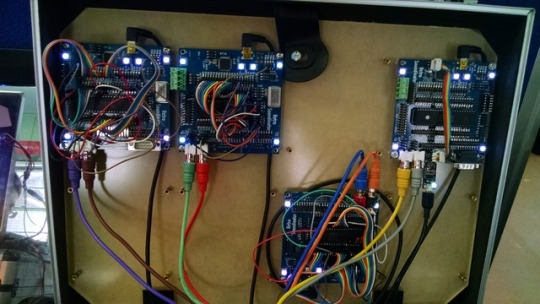

A Chiptune Modular Synthesizer Gig Box
Brendan Becker has a good head for audio synthesizer chips. And he’s been working on something just for that. Basically, it’s a microcontroller board with more than enough space to interface with most common sound synthesizer chips from vintage home computers and game systems, among other things, and the smarts to make it more convenient to use with his modern multi-chip tracker software. He had 4 different sound IC’s hooked in together, controlled from the same machine (including an MOS 6581 SID). I really want to see what becomes of his project, because I’ve got an SAA-1099 that I’d like to put to work. According to Brendan, that would be plenty possible with what he’s working on...
“What happens when your job is to write music on pre-1990s computers and consoles, and things aren’t hard enough as it is? Make them harder, of course, by building your own synthesizer and music software to control it! Inverse Phase will be showing off his in-progress chiptune gig box, which will allow him to produce authentic sound from eight (or more) systems simultaneously, all without having to carry each of the systems to shows and the like. Also available will be demos of various hacked software that enable chiptune creation on modern PCs, which can then be easily ported to retro hardware.”
#vcfexii#VCF East XII#commodorez goes to vcfexii#vintage computer festival east xii#vintage computer festival east#chiptunes#sid chip#tracker software#mod tracker#chiptune#synthesizer
90 notes
·
View notes
Photo

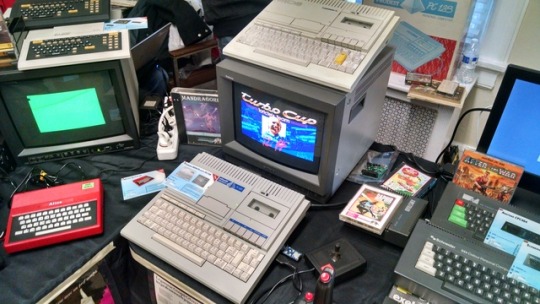
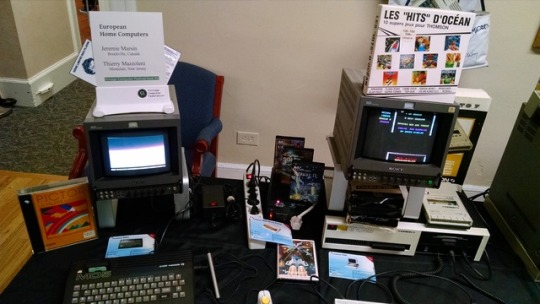
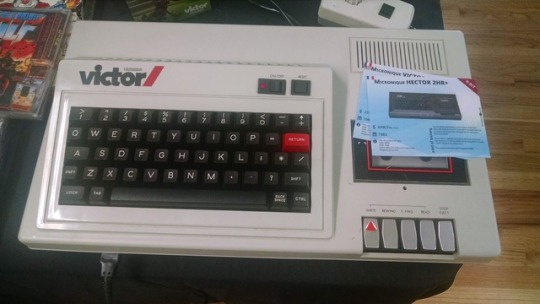

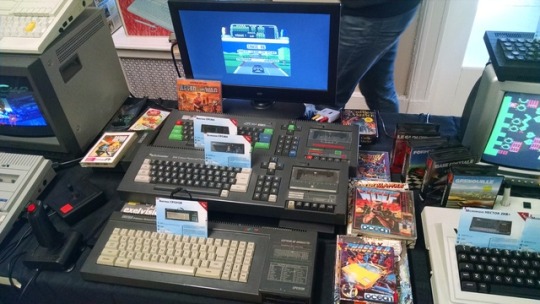

European Home Computers (part 2 of 2)
Is it just me, or are the graphics of these European computers on display here focusing on different color pallets than the American counterparts? Jeremie Marsin & Thierry Mazzoleni sure went to the trouble of showcasing a wide variety of manufacturers.
Oh, and there is one machine here I actually recognize: the Matra-Hachette Alice 32, the bright red Tandy MC-10 clone. I had a dwarf hamster in high school named after its successor, the Alice 90. Jeremie & Thierry said they would try to find one to bring in the future.
“Following our French Computers exhibit from last year, we will expand to all Europe this year with microcomputers from the 1980s and 1990s. France, the U.K., Italy, and possibly even the U.S.S.R. will be represented with machines from Amstrad, Exelvision, Matra-Hackette, Micronique, Olivetti,Philips, Radiola, Schneider, Sinclair, and Thomson.”
#VCF East XII#vcfexii#commodorez goes to vcfexii#vintage computer festival east xii#vintage computer festival#amstrad#exelvision#matra hachette alice 32#micronique#olivetti#philips#radiola#schneider#Sinclair Spectrum#thomson
67 notes
·
View notes